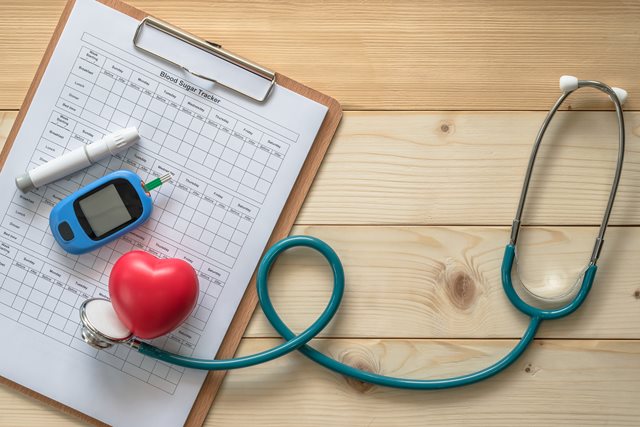Eggs are not only full of important nutrients (protein; choline; vitamins A, D, and B12; folate; iron; and zinc), but are also convenient and cheap. Yet many people still wonder about whether they can eat them regularly. The confusion is based on old scientific research from many decades ago when scientists believed eggs had a powerful effect on raising blood cholesterol levels (which in turn could increase the risk of having a heart attack or stroke). Research now shows this is not the case. For most people—including those with diabetes—the current recommendation is that eggs can be eaten daily. This goes for the whole egg, not just the whites, as most of the nutrients are found in the yolk.
Good news for those with diabetes
With a higher risk of heart disease and stroke in people with diabetes, scientists once thought it best for them to eat fewer foods that might increase that risk. So many people with diabetes have limited the number of eggs they eat. But research published in the American Journal of Clinical Nutrition, shows that if you live with diabetes, you can still enjoy eggs on a daily basis.
Australian scientists compared the impact of a high-egg (12 per week) versus a low-egg (less than two per week) diet on the heart disease and stroke risk factors for people with and without diabetes. Over the nine-month study period, they found no differences in the two groups in terms of risk factors, such as blood sugar and cholesterol readings.
Other health benefits
Numerous studies have compared eggs and other foods to see what effect they have on a person’s appetite and on the amount of food they eat throughout the day. In a study of adult men, scientists compared the effect of eating breakfasts consisting of either eggs or bagels. Both meals provided the same number of calories. Hours later, subjects were given a buffet lunch and instructed to eat until they were satisfied. Not only did the subjects who were given the eggs eat fewer calories at the buffet, but also during the 24-hour period following the test breakfasts. Blood tests of those who were given an egg breakfast also showed better blood sugar and insulin readings and lower levels of hunger hormones at various intervals following breakfast.
A study with overweight women showed similar results: The women ate less food after their egg breakfasts. It stands to reason that if you are less hungry and more satisfied after eating, you will likely eat less later on, making it much easier for you to manage your weight. Being a healthy weight is an important factor in managing blood sugar levels.
A versatile food
Eggs are healthy, delicious, versatile, inexpensive, and a good source of protein. The protein helps you to digest food more slowly, which helps you to feel more satisfied after eating, and to keep blood sugar levels steady,
says Jennifer Buccino, people affected by diabetes (PAD) knowledge & connection executive director at Diabetes Canada. In addition, eggs provide almost no carbohydrate, so they will not raise your blood sugar, adds Buccino, who is also a registered dietitian.
“Eggs can be cooked in many different ways and are easy to combine with other healthy foods like spinach, broccoli, and other vegetables,” she says, adding, “They’re a great way to get more vegetables in the day if you aren’t meeting the recommended intake of vegetables.”
Think of eggs as nature’s fast food. They can be cooked in just minutes. Rather than relying on prepared processed foods, enjoy them hard-boiled, as an omelette, in a frittata, and in soups, vegetable stews, and salads. For more meal-planning ideas, visit Meal Planning.
Here are three examples of just how versatile eggs can be.
Veggie Frittata
This recipe, from Egg Farmers of Ontario, makes a large number of servings, which allows you to enjoy it for dinner and then have the leftovers the next day for breakfast or lunch. You can also change the vegetables and use what is in your fridge. Spinach, zucchini, and broccoli are just a few other options
1 tbsp (15 mL) butter or non-hydrogenated margarine
1 cup (250 mL) mushrooms (about 5), sliced
½ cup (125 mL) chopped green and/or red peppers
⅓ cup (75 mL) chopped onion
12 eggs
¼ cup (50 mL) water
Melt butter in a 10-inch (25 cm) frying pan over medium heat. Add mushrooms, peppers, and onion; sauté until tender, about 10 minutes.
While vegetables are cooking, whisk together eggs and water. Pour egg mixture over vegetables in pan. Cover and cook over medium heat, occasionally poking through the mixture to allow uncooked egg to flow to the bottom of the pan.
When bottom is cooked and top is almost set, finish cooking by covering with a lid for a few minutes, or by flipping frittata over in the pan (or, if pan is ovenproof, cook the top under the broiler).
To flip the frittata, place a dinner plate over pan and hold it firmly in place, then turn both frying pan and plate upside down. The frittata will fall into the plate, top side down. Slide the frittata back into the frying pan, top side down. Cook for a few minutes until bottom side is cooked.
Cut into wedges and serve.
Makes 6 servings
Nutritional breakdown per serving: 2 g carbohydrate, 13 g protein, 12 g total fat, 3 g saturated fat, 1 g fibre, 140 mg sodium, 170 calories
Lentil Egg Skillet Bake
Here is a main course dish all in one, adapted from lentils.org. It is another example of an egg dish you can prepare for one meal and have the leftovers on hand for another.
1½ cups (375 mL) cooked split red lentils
5 slices whole-grain bread
8 eggs
¾ cup (175 mL) skim milk
1 cup (250 mL) finely chopped broccoli
⅓ cup (75 mL) shredded Asiago cheese
⅓ cup (75 mL) shredded
Parmesan cheese
To prepare cooked split red lentils: Combine ½ cup (125 mL) split red lentils with 1½ cups (375 mL) water. Bring to a boil; cover, reduce heat, and simmer for 5-7 minutes, or until lentils are tender. Drain any excess liquid and let cool.
In a large electric skillet or sauté pan over medium-high heat, spray with non-stick cooking spray and place bread slices in pan. Allow bread to lightly brown; turn over and brown on other side.
In a mixing bowl, whisk eggs and milk. Pour egg mixture over bread. Use a spatula to press bread down and allow bread to be covered and soaked by the egg mixture.
Sprinkle with lentils, broccoli, and Asiago and Parmesan cheeses.
Cover and allow to bake until eggs are set and no longer liquid, approximately 15-20 minutes.
Serve immediately, or allow to cool and refrigerate.
Makes 8 servings
Nutritional breakdown per serving: 18 g carbohydrate, 17 g protein, 9 g total fat, 3 g saturated fat, 8 g fibre, 263 mg sodium, 250 calories
Turkish Menemen
This recipe, adapted from the Manitoba Egg Farmers, is an example of how to add protein to vegetable dishes.
½ cup (125 mL) plain yogurt
1 small clove garlic, minced
Pinch each salt, freshly ground pepper, and hot pepper flakes
3 tbsp (45 mL) olive oil
2 cloves garlic, minced
1 onion, sliced
1 green pepper, sliced
½ red chili pepper, sliced into rings (optional)
1 can (796 mL/28 oz.) diced tomatoes
2 tbsp (25 mL) tomato paste
1 tsp (5 mL) each dried oregano and hot or sweet paprika
½ tsp (2 mL) salt, divided
¼ tsp (1 mL) freshly ground pepper
6 eggs
¼ cup (50 mL) chopped parsley
Whole-wheat toast (optional)
Stir yogurt with garlic, salt, pepper, and hot pepper flakes. Refrigerate for up to a few hours until ready to use.
Heat oil in a 10-inch (25 cm) ovenproof skillet set over medium heat. Add garlic, onion, green pepper, and chili pepper (if using). Cook, stirring until softened, or for 3-4 minutes. Stir in tomatoes, tomato paste, oregano, paprika, half the salt, and the pepper. Cook, stirring occasionally, until thickened, or for 18-20 minutes. Preheat broiler to high; position rack 6 inches from heat source. Make 6 wells in mixture; crack an egg into each well. Sprinkle with remaining salt. Cook until egg whites start to set, or for 3-5 minutes. Broil for 1-2 minutes.
Sprinkle with parsley. Serve with yogurt mixture, and with toast, if desired.
Makes 6 servings
Nutritional breakdown per serving: 15 g carbohydrate, 9 g protein, 12 g total fat, 3 g saturated fat, 1 g fibre, 245 mg sodium, 203 calories
Did you know?
Diabetes Canada has new programs to support people with diabetes, including Diabetes Open Hours which are regular virtual, hour-long live events with a community of people with lived and professional diabetes experience. Ask your questions, tell your story and share with others in a safe, non-judgmental space.
This adapted article appeared in Diabetes Dialogue.
Related Content

Nutrition
Learn more about how to incorporate good-for-you foods into your meals.
Get started About Nutrition
Tools & resources
Take charge of your health with tools and resources from Diabetes Canada, such as the glycemic index.
Get started About Tools & resources
Lifestyle management
Find out how to manage your diabetes, including suggestions for helpful self-care practices.
Learn more About Lifestyle management